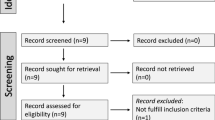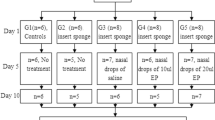Abstract
Chronic pansinusitis is a mucosal inflammation of the nose and all paranasal sinuses with severe inflammation of the upper airways. Asymmetric dimethylarginine (ADMA) is associated with oxidative stress. In this study, we aimed to examine the plasma levels and importance of ADMA and nitric oxide (NO) in patients with chronic pansinusitis. The study was conducted with a total of 64 patients. The study group included a total of 40 patients with chronic pansinusitis. (18 females, 22 males) (mean age 32.27 ± 10.02). The control group consisted of 24 patients (11 females and 13 males). The mean age of the patients in the control group was 31.35 ± 6.05 years. Nasal endoscopic examinations were performed in patients with a history of chronic pansinusitis and symptoms of chronic pansinusitis. Later, the diagnosis of chronic pansinusitis was confirmed with coronal paranasal sinus Computed tomography scans. Plasma ADMA levels were measured by ELISA method and NO levels were measured by Griess method. Plasma ADMA and NO levels of the patients and healthy volunteers were measured and the mean plasma levels of the two groups were compared. ADMA levels were significantly higher in the group with chronic pansinusitis compared to the control group (1.23 ± 0.41 μM and 0.28 ± 0.06 μM, respectively) (p < 0.001), while NO levels were significantly lower in the patient group compared to the control group (7.06 ± 1.07 μM and 12.25 ± 0.95, μM, respectively) (p < 0.001). Our results show that the increase in ADMA levels and the decrease in NO levels are associated with chronic pansinusitis. According to these results, increased plasma levels of ADMA in chronic pansinusitis may be useful in clinical use as a sign of increased oxidative stress.


Similar content being viewed by others
References
Rudmik L, Smith TL, Schlosser RJ et al (2014) Productivity costs in patients with refractory chronic rhinosinusitis. Laryngoscope 124:2007–2012. https://doi.org/10.1002/lary.24630
Tomassen P, Van Zele T, Zhang N et al (2011) Pathophysiology of chronic rhinosinusitis. Proc Am Thorac Soc 8:115–120. https://doi.org/10.1513/pats.201005-036RN
Westerveld GJ, Dekker I, Voss HP et al (1997) Antioxidant levels in the nasal mucosa of patients with chronic sinusitis and healthy controls. Arch otolaryngol head neck surg 123(1):201–204
Alving K, Weitzberg E, Lundberg JM (1993) Increased amount of nitric oxide in exhaled air of asthmatics. Eur Respir J 6:1368–1370
Struben VMD, Wieringa MH, Feenstra L, de Jongste JC (2006) Nasal nitric oxide and nasal allergy. Allergy 61:665–670. https://doi.org/10.1111/j.1398-9995.2006.01096.x
Hayden MR, Tyagi SC (2003) Is type 2 diabetes mellitus a vascular disease (atheroscleropathy) with hyperglycemia a late manifestation? The role of NOS, NO, and redox stress. Cardiovasc Diabetol 2:2. https://doi.org/10.1186/1475-2840-2-2
Nathan C (1997) Inducible nitric oxide synthase: what difference does it make? J Clin Investig 100:2417–2423. https://doi.org/10.1172/JCI119782
Semenza GL (2000) Cellular and molecular dissection of reperfusion injury: ROS within and without. Circ Res 86:117–118
Jorissen M, Lefevere L, Willems T (2001) Nasal nitric oxide. Allergy 56:1026–1033. https://doi.org/10.1034/j.1398-9995.2001.00145.x
Sanders SP, Siekierski ES, Richards SM et al (2001) Rhinovirus infection induces expression of type 2 nitric oxide synthase in human respiratory epithelial cells in vitro and in vivo. J Allergy Clin Immunol 107:235–243. https://doi.org/10.1067/mai.2001.112028
Vallance P, Leone A, Calver A et al (1992) Endogenous dimethylarginine as an inhibitor of nitric oxide synthesis. J Cardiovasc Pharmacol 20(Suppl 12):S60–S62. https://doi.org/10.1097/00005344-199204002-00018
Wells SM, Holian A (2007) Asymmetric dimethylarginine induces oxidative and nitrosative stress in murine lung epithelial cells. Am J Respir Cell Mol Biol 36:520–528. https://doi.org/10.1165/rcmb.2006-0302SM
Nijveldt RJ, Siroen MPC, Teerlink T, van Leeuwen PAM (2004) Elimination of asymmetric dimethylarginine by the kidney and the liver: a link to the development of multiple organ failure? J nutr. https://doi.org/10.1093/jn/134.10.2848S
Németh B, Ajtay Z, Hejjel L et al (2017) The issue of plasma asymmetric dimethylarginine reference range - A systematic review and meta-analysis. PLoS ONE 12:e0177493. https://doi.org/10.1371/journal.pone.0177493
Vallance P, Leiper J (2004) Cardiovascular biology of the asymmetric dimethylarginine:dimethylarginine dimethylaminohydrolase pathway. Arterioscler Thromb Vasc Biol 24:1023–1030. https://doi.org/10.1161/01.ATV.0000128897.54893.26
Cooke JP (2004) Asymmetrical dimethylarginine: the Uber marker? Circulation 109:1813–1818. https://doi.org/10.1161/01.CIR.0000126823.07732.D5
Böger RH, Ron ES (2005) L-Arginine improves vascular function by overcoming deleterious effects of ADMA, a novel cardiovascular risk factor. Altern Med Rev: J Clin Ther 10:14–23
Sydow K, Münzel T (2003) ADMA and oxidative stress. Atheroscler Suppl 4:41–51. https://doi.org/10.1016/s1567-5688(03)00033-3
Sahin M, Arslan C, Naziroglu M et al (2006) Asymmetric dimethylarginine and nitric oxide levels as signs of endothelial dysfunction in Behcet’s disease. Ann Clin Lab Sci 36:449–454
Moshage H, Kok B, Huizenga JR, Jansen PL (1995) Nitrite and nitrate determinations in plasma: a critical evaluation. Clin Chem 41:892–896
Leong T, Zylberstein D, Graham I et al (2008) Asymmetric dimethylarginine independently predicts fatal and nonfatal myocardial infarction and stroke in women: 24-year follow-up of the population study of women in Gothenburg. Arterioscler Thromb Vasc Biol 28:961–967. https://doi.org/10.1161/ATVBAHA.107.156596
Wang P-C, Lin H-C, Kang J-H (2013) Chronic rhinosinusitis confers an increased risk of acute myocardial infarction. Am J Rhinol Allergy 27:e178–e182. https://doi.org/10.2500/ajra.2013.27.3952
Koch A, Weiskirchen R, Kunze J et al (2013) Elevated asymmetric dimethylarginine levels predict short- and long-term mortality risk in critically ill patients. J Crit Care 28:947–953. https://doi.org/10.1016/j.jcrc.2013.05.016
Djupesland PG, Chatkin JM, Qian W, Haight JS (2001) Nitric oxide in the nasal airway: a new dimension in otorhinolaryngology. Am J Otolaryngol 22:19–32. https://doi.org/10.1053/ajot.2001.20700
Böger RH, Maas R, Schulze F, Schwedhelm E (2005) Elevated levels of asymmetric dimethylarginine (ADMA) as a marker of cardiovascular disease and mortality. Clin Chem Lab Med 43:1124–1129. https://doi.org/10.1515/CCLM.2005.196
Chen S, Li N, Deb-Chatterji M et al (2012) Asymmetric dimethyarginine as marker and mediator in ischemic stroke. Int J Mol Sci 13:15983–16004. https://doi.org/10.3390/ijms131215983
Schulze F, Lenzen H, Hanefeld C et al (2006) Asymmetric dimethylarginine is an independent risk factor for coronary heart disease: results from the multicenter coronary artery risk determination investigating the Influence of ADMA Concentration (CARDIAC) study. Am Heart J 152:493.e1–8. https://doi.org/10.1016/j.ahj.2006.06.005
Sydow K, Fortmann SP, Fair JM et al (2010) Distribution of asymmetric dimethylarginine among 980 healthy, older adults of different ethnicities. Clin Chem 56:111–120. https://doi.org/10.1373/clinchem.2009.136200
Vallance P, Leone A, Calver A et al (1992) Accumulation of an endogenous inhibitor of nitric oxide synthesis in chronic renal failure. Lancet 339:572–575. https://doi.org/10.1016/0140-6736(92)90865-z
Kielstein JT, Bode-Böger SM, Frölich JC et al (2003) Asymmetric dimethylarginine, blood pressure, and renal perfusion in elderly subjects. Circ 107:1891–1895. https://doi.org/10.1161/01.CIR.0000060496.23144.A7
Deneva-Koycheva TI, Vladimirova-Kitova LG, Angelova EA, Tsvetkova TZ (2011) Plasma asymmetric dimethylarginine levels in healthy people. Folia Med 53:28–33. https://doi.org/10.2478/v10153-010-0024-z
Naraghi M, Deroee AF, Ebrahimkhani M et al (2007) Nitric oxide: a new concept in chronic sinusitis pathogenesis. Am J Otolaryngol 28:334–337. https://doi.org/10.1016/j.amjoto.2006.10.014
Adappa ND, Zhang Z, Palmer JN et al (2014) The bitter taste receptor T2R38 is an independent risk factor for chronic rhinosinusitis requiring sinus surgery. Int Forum Allergy Rhinol 4:3–7. https://doi.org/10.1002/alr.21253
Bełtowski J, Kedra A (2006) Asymmetric dimethylarginine (ADMA) as a target for pharmacotherapy. Pharmacol Reports: PR 58:159–178
Celermajer DS (1997) Endothelial dysfunction: does it matter? Is it reversible? J Am Coll Cardiol 30:325–333. https://doi.org/10.1016/s0735-1097(97)00189-7
Achan V, Ho HK, Heeschen C et al (2005) ADMA regulates angiogenesis: genetic and metabolic evidence. Vasc Med 10:7–14. https://doi.org/10.1191/1358863x05vm580oa
Stühlinger MC, Abbasi F, Chu JW et al (2002) Relationship between insulin resistance and an endogenous nitric oxide synthase inhibitor. JAMA 287:1420–1426. https://doi.org/10.1001/jama.287.11.1420
Allerton TD, Proctor DN, Stephens JM et al (2018) l-citrulline supplementation: impact on cardiometabolic health. Nutr. https://doi.org/10.3390/nu10070921
Funding
The present study has been supported by Istanbul Rumeli University, through the Scientific Research Project no: 2019010.
Author information
Authors and Affiliations
Corresponding author
Ethics declarations
Conflict of ınterest
The authors declare that they have no conflict of interest.
Additional information
Publisher's Note
Springer Nature remains neutral with regard to jurisdictional claims in published maps and institutional affiliations.
Rights and permissions
About this article
Cite this article
Bulut, F., Türksever Tetiker, A., Çelikkol, A. et al. Plasma Asymmetrıc Dımethylargınıne (ADMA) and Nıtrıc Oxıde (NO) Levels ın Patıents wıth Chronıc Pansınusıtıs. Indian J Otolaryngol Head Neck Surg 74 (Suppl 2), 1591–1596 (2022). https://doi.org/10.1007/s12070-021-02720-8
Received:
Accepted:
Published:
Issue Date:
DOI: https://doi.org/10.1007/s12070-021-02720-8




